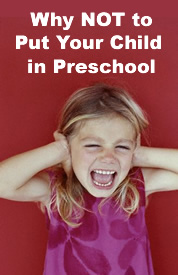What Your Baby Really Needs, Age-by-Age
Posted by homeschoolmentormom on July 28, 2012
Every summer, homeschooling parents spend hours pouring over catalogs and planning their children’s next school year and curriculum. We lay out schedules, set goals, and most importantly, pray over our children’s lives and needs.
I can’t help but wonder: Do we spend half as much time planning for the needs of our babies, toddlers and preschoolers? Don’t they deserve some planning time, too?
No matter your child’s age, a good place to start is by remembering the 4R’s: Relationship, routine, readiness, and reading aloud. Keeping these in mind keeps our goals in proper perspective, helping us to make the main thing the main thing (Relationships with God and family always come first!)
Even though it is a good idea to spend some time planning for them, babies, toddlers and preschoolers don’t need an academically-based “curriculum” (even though they are being offered nowadays!) Work books and flash cards are not appropriate; their best curriculum is life. But the types of learning experiences they need are unique, and not always accomplished without some thought and planning. So here are some thoughts to help you plan for your baby/toddlers needs, age-by-age.
What Your Baby/Toddler Really Needs, Age-by-Age
0-3 months: The goal of baby’s development at this age is simple: bonding with family and growing secure in the love and consistent care he receives. Additionally, to boost brain development, babies need to be read to, sung to, and talked to. Most of all, babies need to be immersed scriptures, praise songs and prayer.
Babies (and toddlers) are unique in that while they require their own daily “lessons” about life, the truth is, they often become the lesson for the rest of the family. They teach our older children patience and selflessness–how to put another’s needs above their own. They teach them to be loving and gentle with those who are young and fragile.
Homeschooling with a baby in tow is exhausting, but it can be done! Plan to take advantage of baby’s nap-times for your older children’s school work. We always saved mid-morning nap-time for phonics, math, and other subjects that require intensive “mommy-time”.
Consider streamlining your school time for a season. After all, you need your rest, too! Alternate science with history or geography, or simply read aloud to your children to cover those topics. Try doing only four “formal” subjects a day: Bible, math, language arts, and a unit study (reading aloud about history or science.) In addition, be sure to incorporate art and music into your daily routine, via free-choice activities or planned activities—at least two or three days a week.
3-6 months—continue as before AND: Babies at this age are learning to control their bodies. Now that their eyes can focus at longer distances, they are becoming more interested in their environments. God designed babies to be especially interested in faces.
3-6 month-olds need opportunities to strengthen their muscles and take in the world from new perspectives. Make sure to give you baby plenty of “floor time”—time on the floor, on his belly. This gives him opportunities to strengthen his neck muscles, arm muscles, and back muscles. Before you know it, your baby will be rolling over, scooting, and then crawling everywhere.
Change your baby’s perspective by moving him from the floor to a swing, or to a bouncer seat (once he can support himself/hold his head up.) Provide rattles and other safe baby toys so that he can learn to control his grip. Once grabbing on is learned, learning to let go is next (and often harder!)
Expose your baby to different textures. Try laying baby on carpet, a soft blanket, or a smooth, cool parachute; lay baby on her back, on her belly, and on her side for a change of pace.
Finally, be sure to take the time to enjoy your baby’s developing social skills. Respond to your baby’s coos, then wait for her to answer you—thus making your first conversations. Play tickle games, make faces at baby, and watch as baby learns to make them back at you.
6-9 months: Baby’s really on the move now! Rolling, scooting, or even crawling his way into trouble. If you want to school in relative peace, you’ll need to make liberal use of playpens or gates…and nap-time. We gated off half our house with an extra long gate, and closed doors to keep our babies where they needed to be. Make sure your house is “baby-proof”. We had to gate off our older children’s rooms so that the Legos and other toys with small parts were out of reach for baby.
Increase the amount of time spent reading to baby, even if you only look at the pictures and talk to baby about them. And if you haven’t already, introduce your baby to classical music, folk music, and of course, praise music. Many babies will try to “dance” while cruising (holding onto a table for balance while trying out his wobbly legs) and some may even try to “sing”. My oldest would cry whenever there was a break between songs, then “dance” again once the music started back up!
Let your older children take turns entertaining baby, and make sure they learn all the little baby songs and ditties you enjoy with baby, so that they can share them with their own children someday. (“X Marks the Spot”, The Wheels on the Bus (move baby’s arms or feet for the wipers, etc.), Open Shut Them, Jesus Loves me, and so on.
At this age, my kiddos loved their bouncy seat (the kind that hangs in a doorway.) The “jumparoo” looks like a good modern alternative. They also enjoyed sitting, propped up in their “Boppy”.
Finally, a warning about television: Even if your baby is interested in the television, try to keep it off completely when s/he is in the room…even those videos designed for babies can’t compare to interaction with real people and real things. In fact, the American Academy of Pediatrics recommends that children under the age to two shouldn’t watch any television at all. Experts have linked television viewing to the development of ADHD, claiming it “rewires” children’s brains.
Next post: Ages 9-12 months, 12-18 months, etc.
© 2012 Susan Lemons all rights reserved. Copyrighted materials may not be re-distributed or re-posted without express permission from the author.






Leave a comment